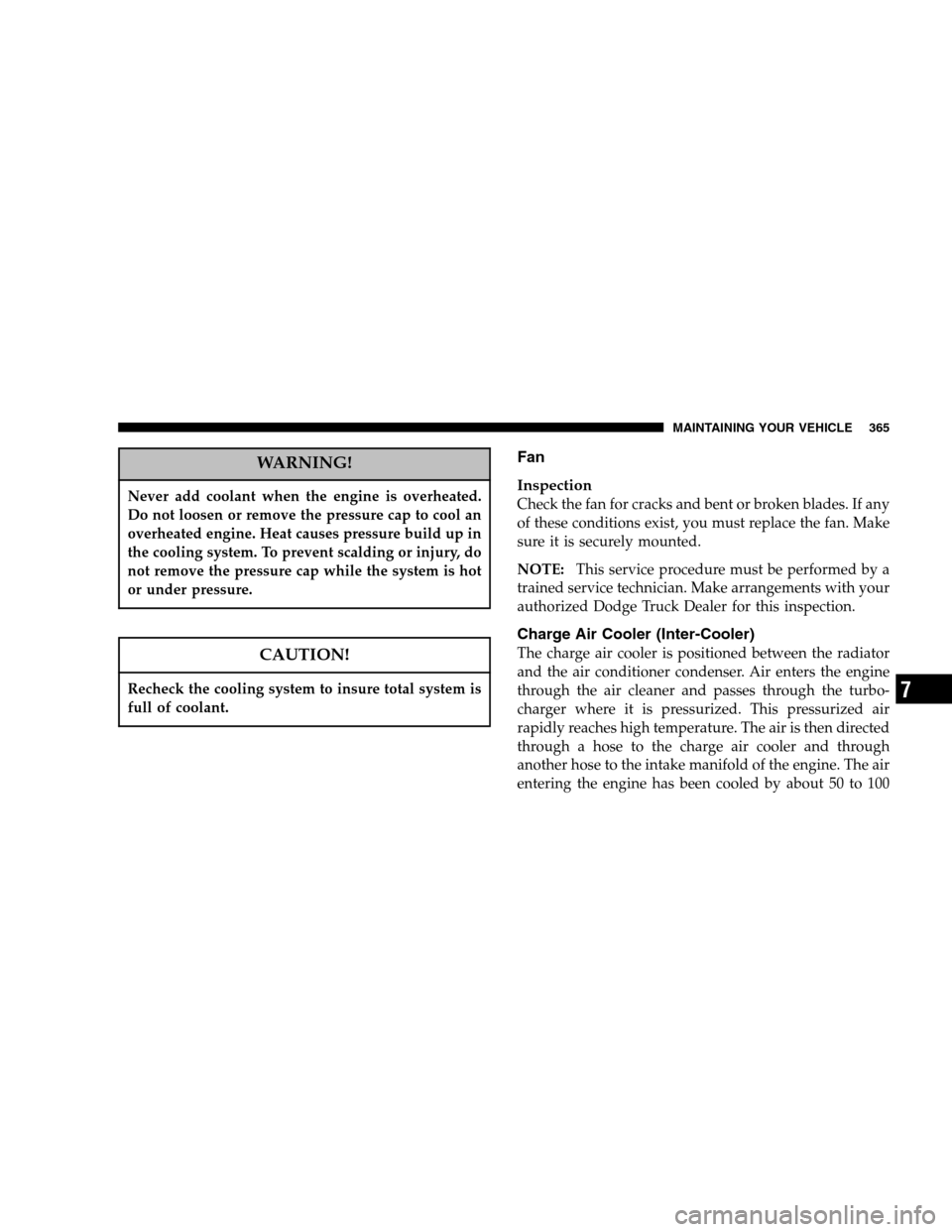Page 361 of 448

of the exhaust system abnormally contacts the under-
body hardware, the isolator and/or hanger should be
replaced.
Cooling System
Cooling System Maintenance
At the intervals shown in the Maintenance Schedules
Section of the manual, the system should be drained,
flushed and filled.
Inspection
Check engine coolant (antifreeze) protection every 12
months (before the onset of freezing weather, where
applicable). If coolant is dirty or rusty in appearance, the
system should be drained, flushed and refilled with fresh
coolant as specified.
Inspect the entire cooling system for leaks. Check the face
of the radiator for any accumulation of bugs, leaves, or
other foreign matter. If dirty, clean the radiator core witha garden hose. With the engine OFF, gently spray water
from the back of the radiator core. Check coolant bottle
tube for condition and tightness of connections at coolant
bottle and radiator.
Extremely cold ambient temperature may require the
addition of a “winter front” for effective operation of the
cab heating/cooling system. Make certain that a percent-
age of the radiator is exposed for adequate air flow
through the charge air cooler and automatic transmission
oil cooler. The percentage of opening must be increased
with the increasing ambient air temperature and/or
engine load. If the cooling fan can be heard cycling
frequently, increase the size of the opening in the winter
front.
Coolant bottle level check
The coolant reserve system provides a quick visual
method of determining that the coolant level is adequate.
With the engine idling, and warmed to the normal
MAINTAINING YOUR VEHICLE 361
7
Page 362 of 448

operating temperature, the level of the coolant on the
coolant bottle should be between the fluid level marks.
Check the coolant level whenever the hood is raised.
The radiator normally remains completely full, so there is
no longer a need to remove the coolant pressure cap
except for checking coolant freeze point or replacement
with new antifreeze coolant.
WARNING!
Never add coolant to the radiator when the engine is
overheated. Do not loosen or remove pressure cap to
cool overheated engine! The coolant is under pres-
sure and severe scalding could result.
Drain, Flush And Refill
At intervals shown on the Maintenance Schedules, the
system should be drained, flushed and refilled. Refer to
your dealer or consult a service manual for proper
procedures.
Adding Coolant
When adding coolant, or refilling the system, a minimum
solution of 50% recommended HOAT ethylene glycol
engine coolant (antifreeze) and distilled water should be
used. Use higher concentrations (not to exceed 70%) if
temperatures below�34°F (�37°C) are anticipated.
Use only high purity water such as distilled or deionized
water when mixing the water/engine coolant solution.
The use of lower quality water will reduce the amount of
corrosion protection in the engine cooling system.
362 MAINTAINING YOUR VEHICLE
Page 363 of 448

NOTE:It is the owner’s responsibility to maintain the
proper level of protection against freezing according to
the temperatures occurring in the area where the vehicle
is operated.
NOTE:Mixing coolant types will decrease the life of the
engine coolant and will require more frequent coolant
changes.
When additional coolant is needed to maintain the
proper level, add the recommended concentration of
antifreeze and water to the overflow bottle. Do not
overfill.
NOTE:Failure to follow the antifreeze concentration
and replacement recommendations, or failure to use
antifreeze formulated to prevent corrosion of all cooling
system metals, may result in radiator plugging, overheat-
ing, or cooling system leaks such as in core hole plugs.WARNING!
Never add coolant to the radiator when the engine is
overheated. Do not loosen or remove pressure cap to
cool an overheated engine. The coolant is under
pressure and severe scalding could result.
Recommended Engine Coolant
Refer to Recommended Fluids, Lubricants and Genuine
Parts for the correct Fluid type.
MAINTAINING YOUR VEHICLE 363
7
Page 364 of 448

CAUTION!
•Mixing of coolants other than specified engine
coolant, may result in engine damage, and de-
crease corrosion protection. If a non-HOAT cool-
ant is introduced into the cooling system in an
emergency, it should be replaced with the speci-
fied coolant as soon as possible.
•Do not use plain water alone or alcohol base
engine coolant (antifreeze) products. Do not use
additional rust inhibitors or antirust products, as
they may not be compatible with the radiator
engine coolant and may plug the radiator.
•This vehicle has not been designed for use with
Propylene Glycol based coolants. Use of Propy-
lene Glycol based coolants is not recommended.
Disposal Of Used Engine Coolant
Used ethylene glycol based engine coolant is a regulated
substance requiring proper disposal. Check with your
local authorities to determine the disposal rules for your
community. Do not store ethylene glycol-based engine
coolant in open containers or allow it to remain in
puddles on the ground. Prevent ingestion by animals and
children. If ingested by a child, contact a physician
immediately. Clean up any ground spills immediately.
Coolant Pressure Cap
The coolant pressure cap must be fully tightened to
prevent loss of coolant and to insure that coolant will
return to the radiator from the coolant reserve tank.
364 MAINTAINING YOUR VEHICLE
Page 365 of 448

WARNING!
Never add coolant when the engine is overheated.
Do not loosen or remove the pressure cap to cool an
overheated engine. Heat causes pressure build up in
the cooling system. To prevent scalding or injury, do
not remove the pressure cap while the system is hot
or under pressure.
CAUTION!
Recheck the cooling system to insure total system is
full of coolant.
Fan
Inspection
Check the fan for cracks and bent or broken blades. If any
of these conditions exist, you must replace the fan. Make
sure it is securely mounted.
NOTE:This service procedure must be performed by a
trained service technician. Make arrangements with your
authorized Dodge Truck Dealer for this inspection.
Charge Air Cooler (Inter-Cooler)
The charge air cooler is positioned between the radiator
and the air conditioner condenser. Air enters the engine
through the air cleaner and passes through the turbo-
charger where it is pressurized. This pressurized air
rapidly reaches high temperature. The air is then directed
through a hose to the charge air cooler and through
another hose to the intake manifold of the engine. The air
entering the engine has been cooled by about 50 to 100
MAINTAINING YOUR VEHICLE 365
7
Page 398 of 448
RECOMMENDED FLUIDS, LUBRICANTS AND GENUINE PARTS
Engine
Component Fluids, Lubricants and Genuine Parts
Engine Coolant Mopar�Antifreeze/Coolant 5 Year/100,000 Mile Formula HOAT (Hybrid Or-
ganic Additive Technology) P/N 5011764AB or equivalent.
Engine Oil For the proper quality and SAE Grade oil for your engine, refer to the section
�Maintenance Procedures.�
Engine Oil Filter Mopar�Engine Oil Filter, P/N 05083285AA or equivalent.
Engine Fuel Filter Mopar�Fuel Filter, P/N 05015581AB or equivalent.
Fuel Selection Refer to the section�Fuel Requirements�for detailed information on fuel se-
lection.
398 MAINTAINING YOUR VEHICLE
Page 402 of 448

EMISSION CONTROL SYSTEM MAINTENANCE
The “Scheduled” maintenance services, listed inbold
typein this section (Section 8) must be done at the times
or mileages specified to assure the continued proper
functioning of the emission control system. These, and all
other maintenance services included in this manual,
should be done to provide best vehicle performance and
reliability. More frequent maintenance may be needed for
vehicles in severe operating conditions such as dusty
areas and very short trip driving.
Inspection and service also should be done any time a
malfunction is suspected.
NOTE:Maintenance, replacement, or repair of the emis-
sion control devices and systems on your vehicle may be
performed by any automotive repair establishment or
individual using any automotive part which has been
certified pursuant to U.S. EPA or, in the State of Califor-
nia, California Air Resources Board regulations.
MAINTENANCE SCHEDULES — 24–VALVE
CUMMINS TURBO DIESEL
There are two maintenance schedules that show the
requiredservice for your vehicle.
First is Schedule“B”. It is for vehicles that are operated
under the conditions that are listed below and at the
beginning of the schedule.
•Frequent short trips where the engine does not achieve
full operating temperature (operating temperature de-
fined as 190° F (66° C) coolant temperature).
•Extensive engine idling (over 10 minutes per hour of
operation) at ambient temperatures less than 32° F (0°
C).
•Driving in dusty conditions.
•Frequent trailer towing.
•Taxi, police, or delivery service (commercial service).
402 MAINTENANCE SCHEDULES
8
M
A
I
N
T
E
N
A
N
C
E
S
C
H
E
D
U
L
E
S
Page 403 of 448

•Off-road or desert operation.
•Extensive operation at high engine speeds (greater
than 2900 rpm) and loads (greater than 70% throttle).
NOTE:Most vehicles are operated under the conditions
listed for Schedule�B�.
NOTE:IfANYof these apply to you then change your
coolant every 102,000 miles (163 000 km) or 60 months,
whichever comes first and follow schedule “B” of the
�Maintenance Schedules�section of this manual.
Second is Schedule“A”. It is for vehicles that are not
operated under any of the conditions listed under Sched-
ule�B�.
Use the schedule that best describes your driving condi-
tions. Where time and mileage are listed, follow the
interval that occurs first.
CAUTION!
Failure to perform the required maintenance items
may result in damage to the vehicle.
At Each Stop for Fuel
•Check the engine oil level about 15 minutes after a
fully warmed engine is shut off. Checking the oil level
while the vehicle is on level ground will improve the
accuracy of the oil level reading. Add oil only when
the level is at or below the ADD or MIN mark.
•Check the windshield washer solvent and add if
required.
•Drain water from the fuel filter.
MAINTENANCE SCHEDULES 403
8
M
A
I
N
T
E
N
A
N
C
E
S
C
H
E
D
U
L
E
S